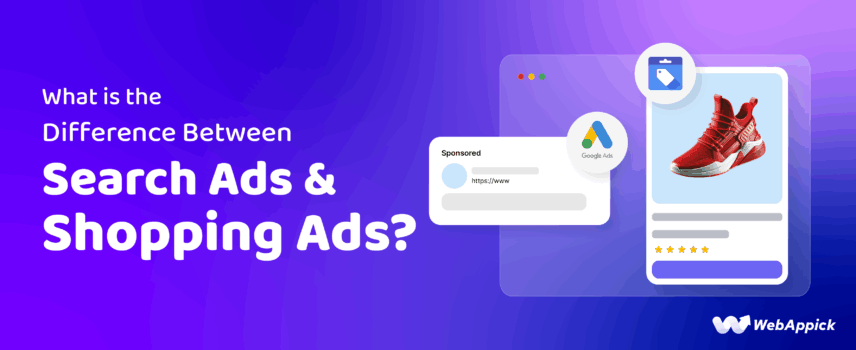
What is the Difference Between Search Ads and Shopping Ads?
In the world of online advertising through Google Ads, two of the most commonly discussed formats are Search Ads and Shopping Ads.
Understanding how they differ and when to use each is crucial for maximizing the effectiveness of your PPC budgets, especially if you operate in e-commerce or digital services.
This article will dig into the key contrasts between these formats, their mechanics, and strategic implications.
What are Search Ads?
Search Ads (also called “text search ads,” “keyword-based ads,” or simply “search advertising”) are the classic form of pay-per-click (PPC) advertising on Google. They’re triggered by keywords that advertisers choose.
When a user types a query into Google Search that matches one of the selected keywords (or variant match types), an ad may appear.
These are managed in Google Ads and typically consist of text only (headline + description + ad extensions).
Key Characteristics:
- Advertiser selects the keywords (e.g., “running shoes for men,” “hire web design service”).
- The advertiser controls ad copy: you write the headlines, descriptions, choose landing pages, extensions, etc.
- Ideal for promoting both products and services (or any offering where you have a defined message, landing page, and want to capture intent via keywords).
- Format: text only (although you may use extensions like sitelinks, callouts, structured snippets).
- Mechanism: Keyword → ad auction → ad appears if quality/bid is appropriate.
What are Shopping Ads?
Shopping Ads (often called “product listing ads” or PLAs) are another campaign type in Google Ads, especially relevant to e-commerce/retail.
These rely on a product feed (via Google Merchant Center) and show rich visual listings (product image, price, store name, sometimes reviews) when a user searches for a product or browses shopping results.
Key characteristics:
- Advertiser uploads a product feed (with product attributes: title, description, image, price, availability, etc) to the Merchant Center, which connects to Google Ads.
- No keyword list for each ad group (in the traditional sense). Instead, Google matches user queries to products based on the feed data.
- Format: image + product title + price + store name (and often promotional features) displayed in search results or the Shopping tab.
- Ideal for physical products / retail inventory; less typical for pure services.
- Mechanism: Product feed + auto-matching → ad shows when Google determines relevance.

Side-By-Side Contrast
| Feature | Search Ads | Shopping Ads |
| Triggering mechanism | Keywords chosen by the advertiser. | Product feed data: Google matches products to queries. |
| Ad format | Text-based (headline + description + extensions). | Visual product card (image, title, price, store). |
| Control over ad copy | High: You craft the copy. | Lower: feed drives what’s shown; less customizable per query. |
| Ideal use case | Services, lead gen, broad product awareness, research-phase intent. | Retail e-commerce, direct product sales, purchase-ready intent. |
| Setup complexity | Moderate: create campaign, select keywords, write ads, set extensions. | Added logistics: prepare product feed, ensure Merchant Center compliance, and sync data. |
| Keyword reliance | Explicit keyword targeting & match types. | Implicit: Google uses product data rather than you listing thousands of keywords. |
| Metrics/strategy differences | Focus on keywords, quality score, ad copy, CTR, and relevance. | Focus on feed quality (titles, attributes, images), product-level bids, and availability. |
| Best when | You can precisely define user intent via keywords; you’re selling services or products where descriptive copy helps. | You have many products, want to showcase images & price upfront, and aim for direct purchase. |
Strategic implications
When to use Search Ads vs Shopping Ads
- Suppose you’re promoting a service (e.g., consulting, SaaS, or local business) or want to capture users still doing research. In that case, Search Ads are typically more appropriate—because you can target keywords related to problems/solutions, craft copy, and use extensions to drive leads.
- Suppose you have a large catalogue of physical products and you want to drive sales (especially when users are already in “buying mode”). In that case, Shopping Ads often perform better—they allow users to see the product image, price, and brand right away, and that tends to drive more qualified clicks.
- Combining both is often beneficial. Many e-commerce advertisers run both Search and Shopping campaigns in parallel to cover different stages of the funnel: Search for discovery & brand or service keywords; Shopping for product-specific purchasing intent.
Cost, ROI, and Performance Considerations
- Although both ad types operate on a PPC model, the cost drivers vary. For Search Ads, you’re bidding on keywords whose competition and cost vary widely depending on the market. For Shopping Ads, the cost is still via auctions, but your product feed quality and relevance play a larger role.
- Return on Ad Spend (ROAS) may differ: Because Shopping Ads show more product info upfront, the click might be more qualified (higher intent) and conversion rates can be higher—but this isn’t guaranteed and depends heavily on feed quality and product–search match.
- With Search Ads, you might get broader demand capture (including research-phase traffic), which can mean higher volume but possibly lower conversion per click; Shopping Ads might yield fewer clicks but more purchase-ready traffic.
Setup & Management Tips
- For Search Ads: Conduct thorough keyword research, build negative keyword lists, optimize ad copy and landing pages, and use ad extensions.
- For Shopping Ads: Spend effort on feed optimization: product titles with keywords, accurate descriptions, high-quality images, correct price/availability, and ensure Merchant Center data is up to date. Poor feed data is one of the main limiting factors.
- Monitor impression share, CTR, conversion rate, and ROAS for each campaign type. Use separate budgets/campaigns so you can analyze performance by format.
- Consider the user journey: Use Search Ads to capture early-stage intent; use Shopping Ads to capture later-stage intent.
- Test, iterate, and optimize: For example, you might run Search Ads for a subset of high-value keywords and Shopping Ads for your broader product catalogue and then shift budget toward the better-performing format.
Emerging Trends & What To Watch
- The advertising ecosystem is evolving: for example, Google has begun integrating ads into its AI-driven search “Overview” results and “AI Mode,” meaning the search ad landscape is shifting.
- Feed quality and automation are increasingly important for Shopping Ads—Google’s algorithms are better at matching queries to products than ever, so maintaining accurate, rich product data is key.
- For Search Ads, machine learning bidding strategies (e.g., target ROAS, target CPA) are increasingly the norm. For Shopping Ads, smart bidding and automated campaigns (or using Performance Max) may reduce manual effort but require strong baseline data and feed hygiene.
- Privacy and tracking changes continue to impact how all online advertising works. While this affects both Search and Shopping, the reliance on feed-driven data (Shopping Ads) vs keyword-driven data (Search Ads) may mean varying degrees of impact.
- Global and local variation: For advertisers based in markets like Bangladesh (Dhaka), regional cost structures, bidding competition, local currency fluctuations, and product shipping/logistics may influence which format is more efficient.
In summary, Search Ads are keyword-driven, text-based, and ideal for capturing user intent across products and services, while Shopping Ads are feed-based, visual listings best suited for e-commerce and high-purchase-intent audiences.
The key differences lie in the triggering method (keywords vs. product data), format (text vs. image), and goal (broad intent vs. direct sales).
Both work best together in a modern paid-search strategy, with the choice depending on your business model, campaign objectives, and management capacity.
